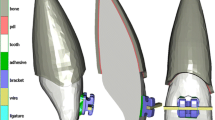Abstract.
Within the scope of indirect orthodontic implant anchorage, the transpalatal bar (TPB) transmits the forces applied at the anchorage teeth to an implant inserted into the palate. It is thus the connecting element between teeth and palatal implant. The aim of the present study was to analyze the extent of sagittal deflection of TPBs of different dimensions attached to an implant abutment. For this purpose, commercially available stainless steel wires measuring 1.2 mm × 1.2 mm (n = 25) and 0.8 mm × 0.8 mm (n = 25) respectively were bent to comply with a representative bend specified with respect to casts, fixed with clamp caps to the implant abutment, and exposed for forces of 50, 100, 150, 200 and 300 cN. The mean deflection of the 1.2 mm × 1.2 mm TPB was lower by a factor of 4.5 than that of the 0.8 mm × 0.8 mm TPB. With a clinically relevant load of 200 cN, for example, the mean deflection of the 1.2 mm × 1.2 mm (0.051” × 0.051”) TPB was 301 µm, whereas that of the 0.8 mm × 0.8 mm (0.032” × 0.032”) TPB was 1337 µm. When maximum anchorage is required, 1.2 mm × 1.2 mm (0.051” × 0.051”) TPBs should be used as a matter of principle.
Zusammenfassung.
Der Transpalatinalbügel (TPB) überträgt im Rahmen der indirekten orthodontischen Implantatverankerung die an den Verankerungszähnen angreifenden Kräfte auf ein am Gaumen inseriertes Implantat. Er ist somit das Verbindungselement zwischen Zähnen und Gaumenimplantat. Ziel dieser Untersuchung war, das Ausmaß der Deflektion in der Sagittalen von am Implantat-Abutment befestigten TPB unterschiedlicher Dimension zu analysieren. Dazu wurden kommerziell erhältliche Edelstahldrähte der Dimension 1,2 mm × 1,2 mm (n = 25) sowie 0,8 mm × 0,8 mm (n = 25) entsprechend einer anhand von Modellen ermittelten repräsentativen Biegevorlage gebogen, mit Klemmkappen am Implantat-Abutment fixiert und Kräften von 50, 100, 150, 200 und 300 cN ausgesetzt. Die Deflektion der TPB der Dimension 1,2 mm × 1,2 mm war im Mittel um den Faktor 4,5 geringer als die der Dimension 0,8 mm × 0,8 mm. Bei einer klinisch relevanten Belastung von z. B. 200 cN kam es bei den TPB der Dimension 1,2 mm × 1,2 mm (0.051“ × 0.051“) zu einer mittleren Deflektion von 301 µm, während sie bei den TPB der Dimension 0,8 mm × 0,8 mm (0.032“ × 0.032“) 1337 µm betrug. Wird eine maximale Verankerung angestrebt, sollten ausschließlich TPB der Dimension 1,2 mm × 1,2 mm (0.051“ × 0.051“) verwendet werden.
Similar content being viewed by others
Author information
Authors and Affiliations
Corresponding author
Rights and permissions
About this article
Cite this article
Wehrbein, H., Hövel, P., Kinzinger, G. et al. Load-Deflection Behavior of Transpalatal Bars Supported on Orthodontic Palatal Implants. J Orofac Orthop 65, 312–320 (2004). https://doi.org/10.1007/s00056-004-0337-8
Received:
Accepted:
Issue Date:
DOI: https://doi.org/10.1007/s00056-004-0337-8
Key Words:
- Orthodontic anchorage implant
- Palate
- Transpalatal bar
- Load-deflection behavior
- Wire dimension
- Maximum anchorage




